| Contents [0/63] |
| Object-Oriented Design & Patterns [1/63] |
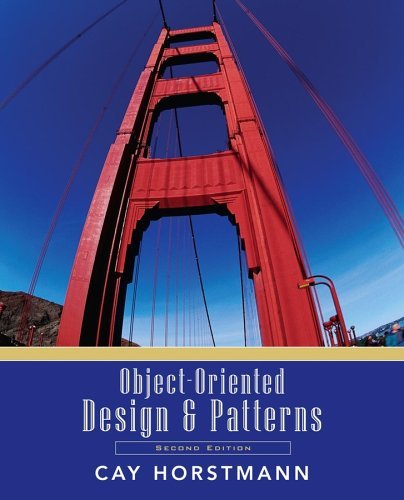
| Chapter Topics [2/63] |
| Frameworks [3/63] |
| Application Frameworks [4/63] |
| Applets [5/63] |
| Applets [6/63] |
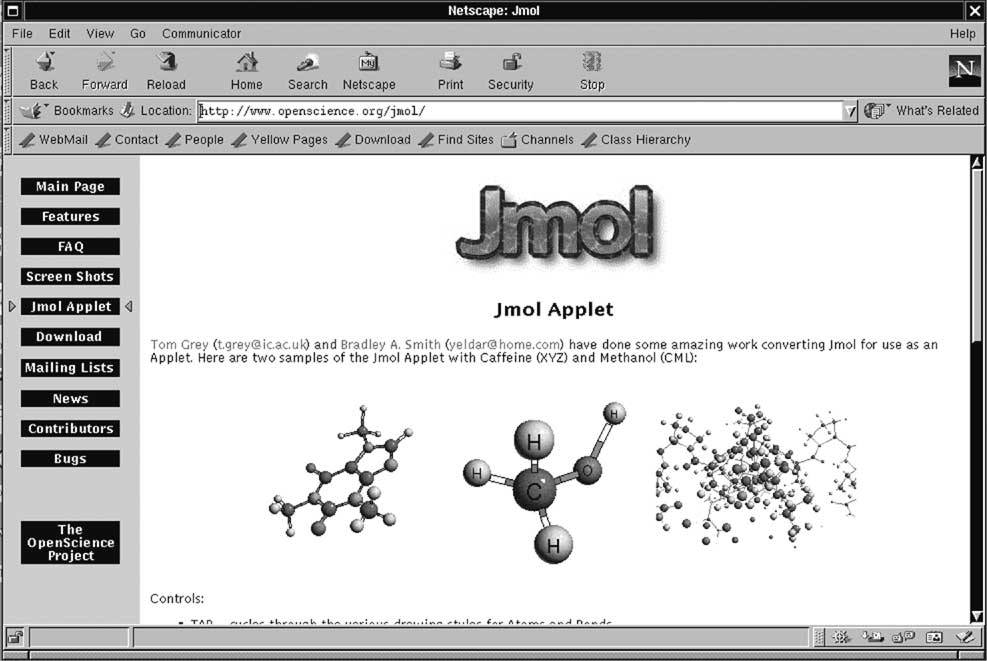
| Applets [7/63] |
<applet code="BannerApplet.class" width="300" height="100">
<param name="message" value="Hello, World!"/>
<param name="fontname" value="Serif"/>
<param name="fontsize" value="64"/>
<param name="delay" value="10"/>
</applet>
| Example Applet [8/63] |
file:horstmann/ch08_applet/BannerApplet.java [source] [doc-public] [doc-private]
01
02
03
04
05
06
07
08
09
10
11
12
13
14
15
16
17
18
19
20
21
22
23
24
25
26
27
28
29
30
31
32
33
34
35
36
37
38
39
40
41
42
43
44
45
46
47
48
49
50
51
52
53
54
55
| Example Applet [9/63] |
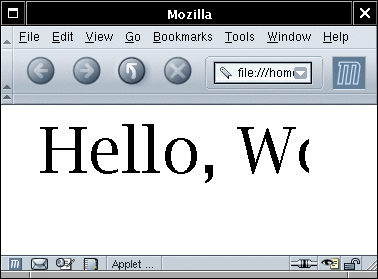
| Applets as a Framework [10/63] |
| Collections Framework [11/63] |
| Collections Framework: Interface Types [12/63] |
| Collections Framework: Classes [13/63] |
| Collections Framework [14/63] |
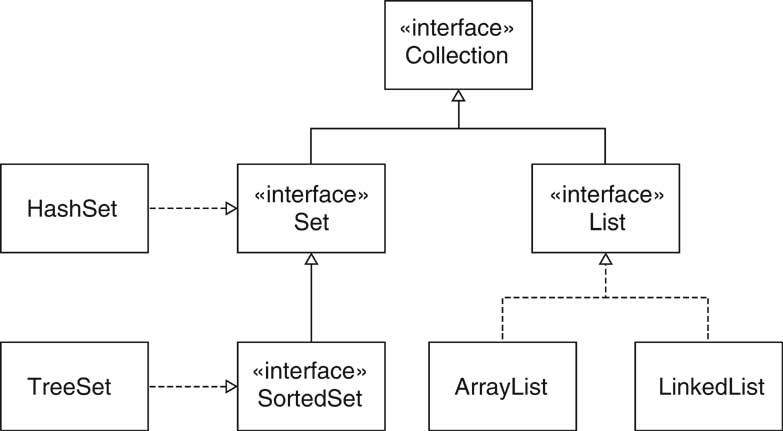
| Collection<E> Interface Type [15/63] |
boolean add(E obj)
boolean addAll(Collection c)
void clear()
boolean contains(E obj)
boolean containsAll(Collection c)
boolean equals(E obj)
int hashCode()
boolean isEmpty()
Iterator iterator()
boolean remove(E obj)
boolean removeAll(Collection c)
boolean retainAll(Collection c)
int size()
E[] toArray()
E[] toArray(E[] a)
| Iterator<E> Interface Type [16/63] |
| AbstractCollection Class [17/63] |
| AbstractCollection Class [18/63] |
| Adding a new Class to the Framework [19/63] |
file:horstmann/ch08_queue/BoundedQueue.java [source] [doc-public] [doc-private]
001
002
003
004
005
006
007
008
009
010
011
012
013
014
015
016
017
018
019
020
021
022
023
024
025
026
027
028
029
030
031
032
033
034
035
036
037
038
039
040
041
042
043
044
045
046
047
048
049
050
051
052
053
054
055
056
057
058
059
060
061
062
063
064
065
066
067
068
069
070
071
072
073
074
075
076
077
078
079
080
081
082
083
084
085
086
087
088
089
090
091
092
093
094
095
096
097
098
099
100
101
102
103
104
105
106
107
file:horstmann/ch08_queue/QueueTester.java [source] [doc-public] [doc-private]
01
02
03
04
05
06
07
08
09
10
11
12
13
14
15
16
17
18
19
20
21
22
| Adding a new Class to the Framework [20/63] |

| Sets [21/63] |
| Lists [22/63] |
| List Iterators [23/63] |
| List Classes [24/63] |
| List Classes [25/63] |

| Optional Operations [26/63] |
| Views [27/63] |
| Views [28/63] |
| Graph Editor Framework [29/63] |
| Graph Editor Framework [30/63] |
| User Interface [31/63] |
| User Interface [32/63] |
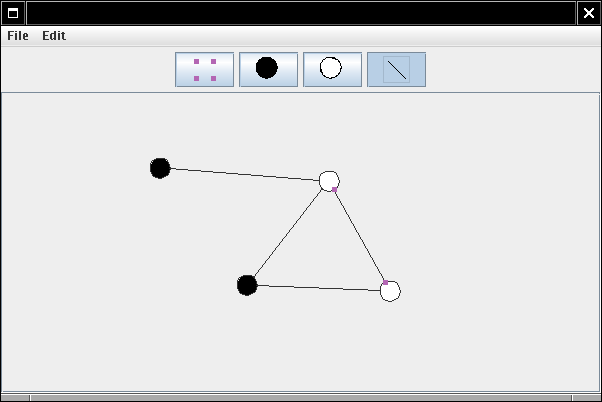
| Mouse Operations [33/63] |
| Division of Responsibility [34/63] |
| Adding Nodes and Edges [35/63] |
| Adding Nodes and Edges [36/63] |
| PROTOTYPE Pattern [37/63] |
| PROTOTYPE Pattern [38/63] |
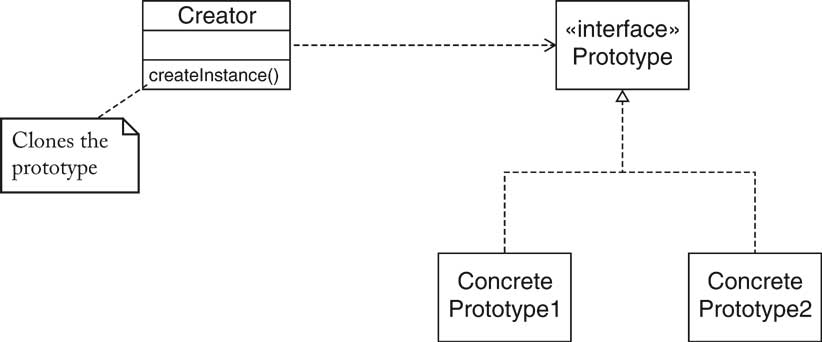
| PROTOTYPE Pattern [39/63] |
| Name in
Design Pattern |
Actual name
(graph editor) |
|
Prototype |
Node |
|
ConcretePrototype1 |
CircleNode |
| Creator |
The GraphPanel that
handles the mouse operation for adding new nodes |
| Framework Classes [40/63] |
| Node Connection Points [41/63] |
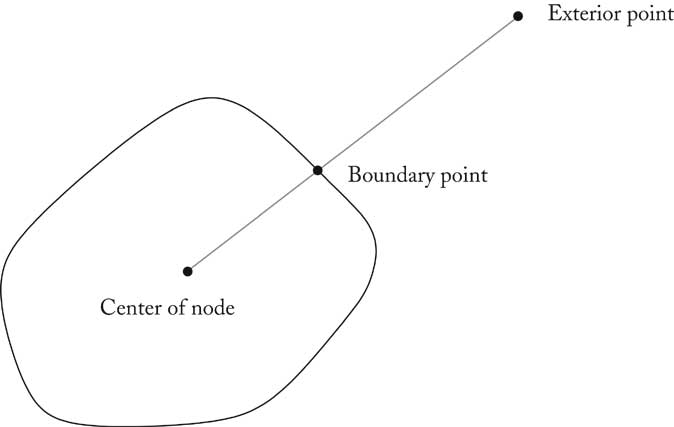
| Framework Classes [42/63] |
file:horstmann/ch08_graphed/Node.java [source] [doc-public] [doc-private]
01
02
03
04
05
06
07
08
09
10
11
12
13
14
15
16
17
18
19
20
21
22
23
24
25
26
27
28
29
30
31
32
33
34
35
36
37
38
39
40
41
42
43
44
45
46
47
48
49
file:horstmann/ch08_graphed/Edge.java [source] [doc-public] [doc-private]
01
02
03
04
05
06
07
08
09
10
11
12
13
14
15
16
17
18
19
20
21
22
23
24
25
26
27
28
29
30
31
32
33
34
35
36
37
38
39
40
41
42
43
44
45
46
47
48
49
50
51
52
53
54
55
56
57
58
59
60
61
file:horstmann/ch08_graphed/AbstractEdge.java [source] [doc-public] [doc-private]
01
02
03
04
05
06
07
08
09
10
11
12
13
14
15
16
17
18
19
20
21
22
23
24
25
26
27
28
29
30
31
32
33
34
35
36
37
38
39
40
41
42
43
44
45
46
47
48
49
50
51
52
53
54
55
56
57
58
59
60
61
62
63
64
65
66
| Framework Classes [43/63] |
file:horstmann/ch08_graphed/Graph.java [source] [doc-public] [doc-private]
001
002
003
004
005
006
007
008
009
010
011
012
013
014
015
016
017
018
019
020
021
022
023
024
025
026
027
028
029
030
031
032
033
034
035
036
037
038
039
040
041
042
043
044
045
046
047
048
049
050
051
052
053
054
055
056
057
058
059
060
061
062
063
064
065
066
067
068
069
070
071
072
073
074
075
076
077
078
079
080
081
082
083
084
085
086
087
088
089
090
091
092
093
094
095
096
097
098
099
100
101
102
103
104
105
106
107
108
109
110
111
112
113
114
115
116
117
118
119
120
121
122
123
124
125
126
127
128
129
130
131
132
133
134
135
136
137
138
139
140
141
142
143
144
145
146
147
148
149
150
151
152
153
154
155
156
157
158
159
160
161
162
163
164
165
166
167
168
169
170
171
172
173
174
175
176
177
178
179
180
181
182
183
184
| Framework UI Classes [44/63] |
| A Framework Instance [45/63] |
| Programmer responsibilities [46/63] |
| A Framework Instance [47/63] |
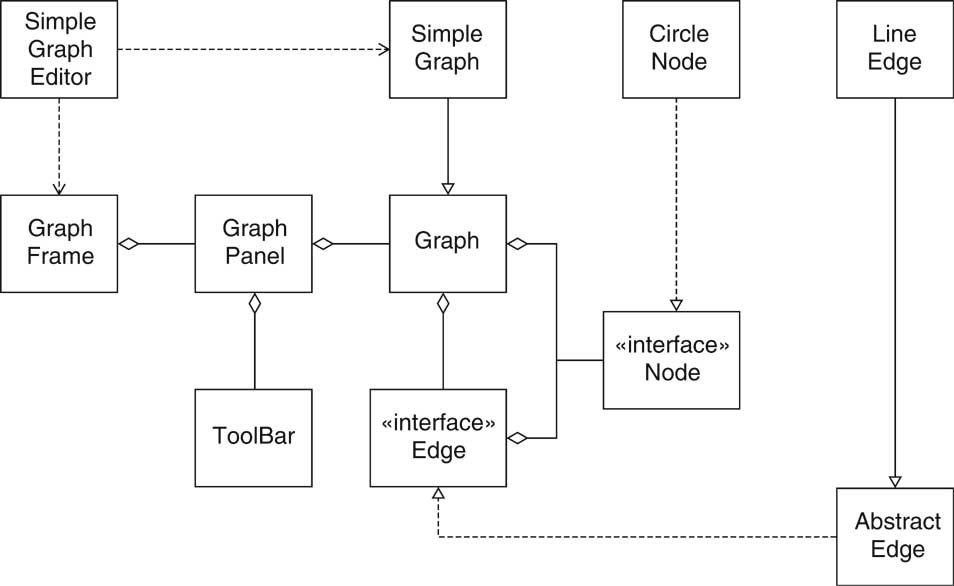
| A Framework Instance [48/63] |
file:horstmann/ch08_graphed/SimpleGraph.java [source] [doc-public] [doc-private]
01
02
03
04
05
06
07
08
09
10
11
12
13
14
15
16
17
18
19
20
21
22
23
24
25
26
27
28
29
30
31
32
33
file:horstmann/ch08_graphed/SimpleGraphEditor.java [source] [doc-public] [doc-private]
01
02
03
04
05
06
07
08
09
10
11
12
13
14
15
file:horstmann/ch08_graphed/CircleNode.java [source] [doc-public] [doc-private]
01
02
03
04
05
06
07
08
09
10
11
12
13
14
15
16
17
18
19
20
21
22
23
24
25
26
27
28
29
30
31
32
33
34
35
36
37
38
39
40
41
42
43
44
45
46
47
48
49
50
51
52
53
54
55
56
57
58
59
60
61
62
63
64
65
66
67
68
69
70
71
72
73
74
75
76
77
78
79
80
81
82
83
84
85
86
file:horstmann/ch08_graphed/LineEdge.java [source] [doc-public] [doc-private]
01
02
03
04
05
06
07
08
09
10
11
12
13
14
15
16
17
18
19
20
21
22
| Generic Framework Code [49/63] |
| Add New Node [50/63] |
public void mousePressed(MouseEvent event)
{
Point2D mousePoint = event.getPoint();
Object tool = toolBar.getSelectedTool();
...
if (tool instanceof Node)
{
Node prototype = (Node) tool;
Node newNode = (Node)prototype.clone();
graph.add(newNode, mousePoint);
}
...
repaint();
}
| Add New Node [51/63] |
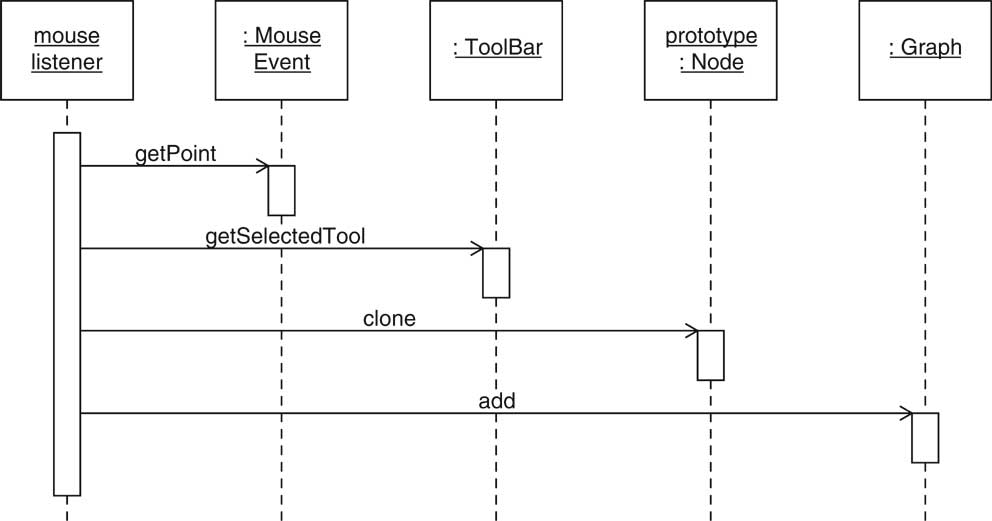
| Add New Edge [52/63] |
| Add New Edge [53/63] |
| Add New Edge [54/63] |
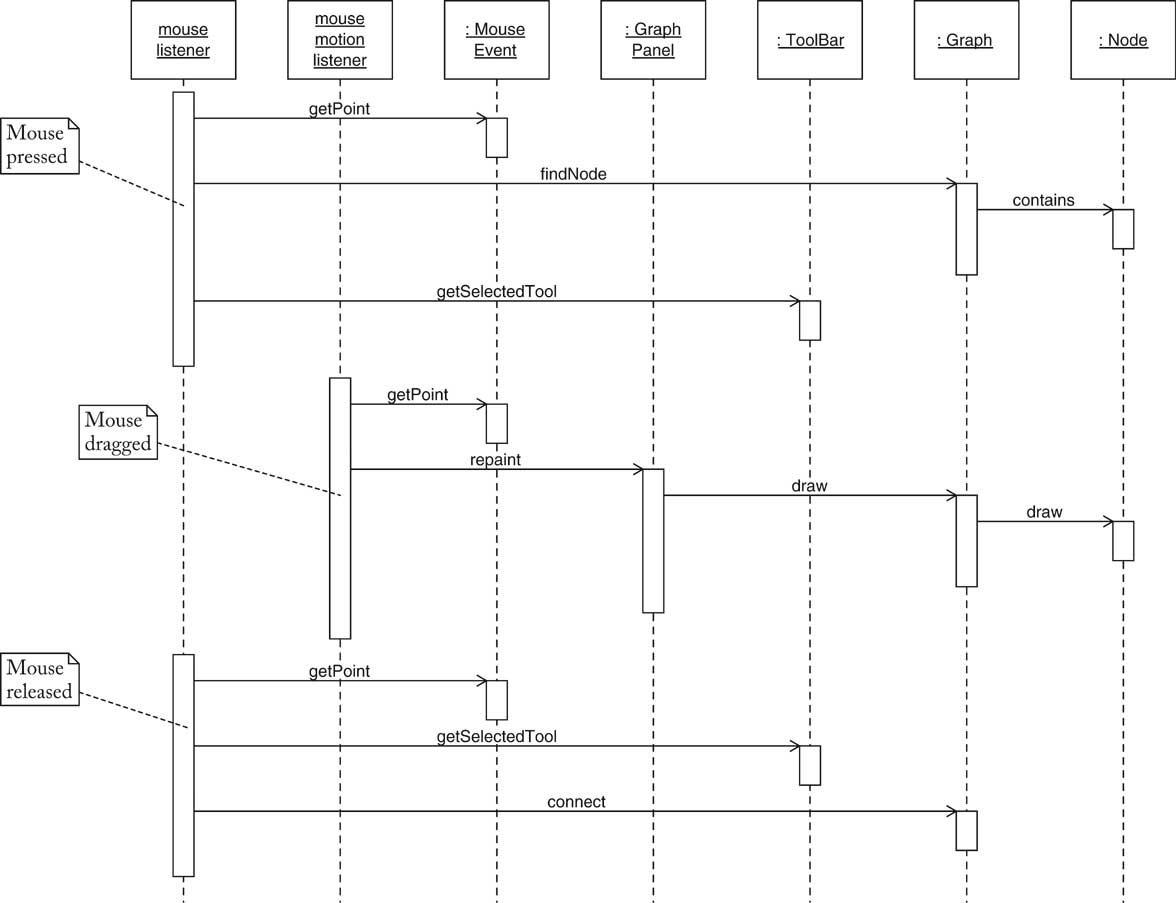
| Enhancing the Framework [55/63] |
| Enhancing the Framework [56/63] |
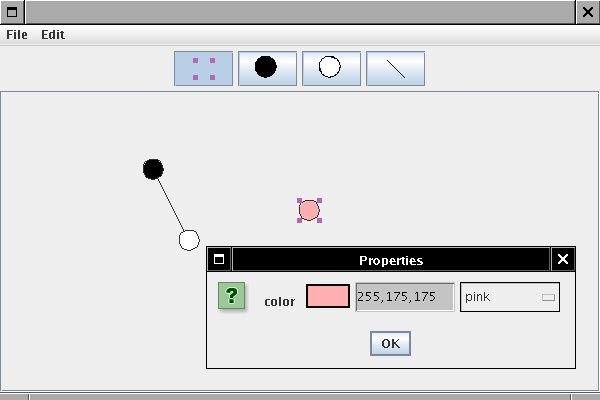
| Enhancing the Framework [57/63] |
| Using the Framework Enhancement [58/63] |
| Another Framework Instance [59/63] |
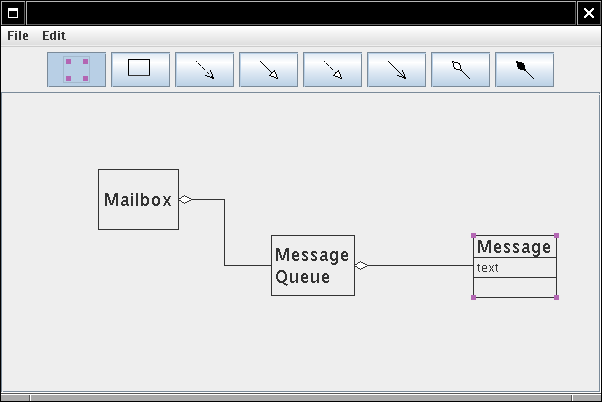
| Another Framework Instance [60/63] |
| Edge Properties [61/63] |

| Enhancing the Framework II [62/63] |
| Enhancing the Framework II [63/63] |

Revised: 2007/09/11 16:38